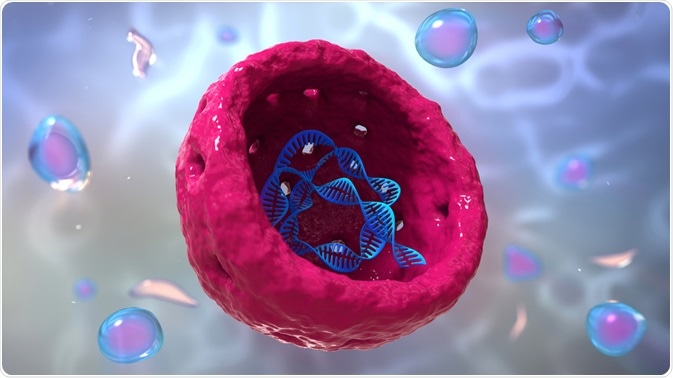What is the nucleus?
The cell nucleus is an organelle that has the function of maintaining and expressing the genome. Maintenance of the nuclear structure and inner organization is vital for the functionality of most cell types. Thus, there are a variety of processes that work to reduce nuclear damage via the removal of non-functional or damaged components.
 Image Credits: urfin / Shutterstock.com
Image Credits: urfin / Shutterstock.com
Scientific studies on both mammalian and yeast cells have been found to support the conclusion that the selective digestion of parts of the nucleus can happen in order to maintain the integrity of the nucleus.
What is nucleophagy?
Under particular circumstances, the elimination of non-essential or damaged components of the nucleus, or even the nucleus in its entirety, is essential in order to encourage the longevity of cells and to ensure appropriate function. A type of selective autophagy, otherwise known as nucleophagy, can be utilized by the cells to degrade any nucleus-derived material in a scenario where it is damaged.
Autophagy is a procedure consisting of self-cannibalism, where internal cellular material is taken in by double-membraned autophagosomes, and is ultimately destroyed via cellular digestion.
The initial steps in the process of autophagy include the development of an ‘isolation membrane’ via the activation of several genetic complexes. At the final stages of autophagy, autophagosomes fuse with a selection of lysosomes, which results in autolysosomes that can function during the degradation process.
Recently, new scientific studies are starting to detail the individual steps involved in the final stages of the autophagy process, during which the autolysosomes can be recycled back into lysosomes via an operation called autophagic lysosome reformation.
How does nucleophagy work?
Autophagy is a name that covers many processes in which organelles and cytosol can be sent to the lysosome for breakdown and possible recycling. Previous studies have sought to investigate the stages of autophagy within the nucleus (nucleophagy) in a type of yeast called Saccharomyces cerevisiae by utilizing genetically encoded fluorescent markers, and reporting on the actions taken in this process.
The use of nuclear reporter ‘n-Rosella’, has previously proven the basis of assays based on either following degradation or accumulation within the cell’s vacuole. These studies have also evaluated the delivery of the n-Rosella fluorescent reporter into the vacuole, but only after prolonged periods of starvation from nitrogen.
For instance, the dual-labeling of specific cells using Nvj1p-EYFP, a nuclear membrane reporter used to detect piece-meal micronucleophagy of the nucleus, allows for the detection and observation of the nucleus degradation soon after the initiation of nitrogen starvation. The delivery of the nuclear components to the vacuole could be observed only after extended periods of nitrogen starvation.
This delayed delivery of the nuclear components to the vacuole has been termed ‘late nucleophagy’. Only a small number of cells showed synchronous accumulation of both of the chosen reporters (Nvj1p-EYFP and NAB35-DsRed.T3) inside the vacuole. It was therefore determined in this study that the final delivery of both of the nuclear reporters to the vacuole is temporally and spatially separated.
How does nucleophagy cause disease?
Abnormalities within the nucleus are outstanding in progeria and other degenerative disease syndromes. The selective autophagy of damaged organelles is crucial for maintaining cell homeostasis, and therefore is vital in the prevention of premature aging.
Although the nucleus is widely regarded as the control center of the cell via controlling gene expression and safeguarding our DNA, very little is known when it comes to the physiological effects of nuclear autophagy. The scrupulous nature of breaking down RNA, DNA, nucleoli, and nuclear envelope components has been highlighted in a variety of recent scientific studies. The Potential impact of disturbed nucleophagy during senescence and general longevity has also been examined in these studies.
For example, the formation of micronuclei has been evaluated in several human disease situations, such as different types of cancer and Bloom syndrome. The total relevance of this process in the context of human disease progression and pathology remains to be fully investigated.
In conclusion, nucleophagy is a well-researched process in the context of general biochemical processes on a molecular level. However, when it comes to the links between this process and human disease, there is much more research to be done in this area before any more definitive conclusions can be made. The potential for the development of disease treatments or prevention methods is therefore a long way away, and could be decades in the making.
Sources
Papandreou M. and Tavernarakis N. (2019). Nucleophagy: from homeostasis to disease. https://doi.org/10.1038/s41418-018-0266-5
Mijaljica D. et al. (2012). A Late Form of Nucleophagy in Saccharomyces cerevisiae. https://doi.org/10.1371/journal.pone.0040013
Hayat M.A. (2015). Autophagy: Cancer, Other Pathologies, Inflammation, Immunity, Infection, and Aging. www.sciencedirect.com/.../autophagy-cancer-other-pathologies-inflammation-immunity-infection-and-aging
Peng H. and Lavker R. (2016). Nucleophagy: A New Look at Past Observations. https://doi.org/10.1016/j.jid.2016.04.019
Mijaljica D. and Devenish R. (2013). Nucleophagy at a glance. doi: 10.1242/jcs.133090
Further Reading
Last Updated: Jun 5, 2020